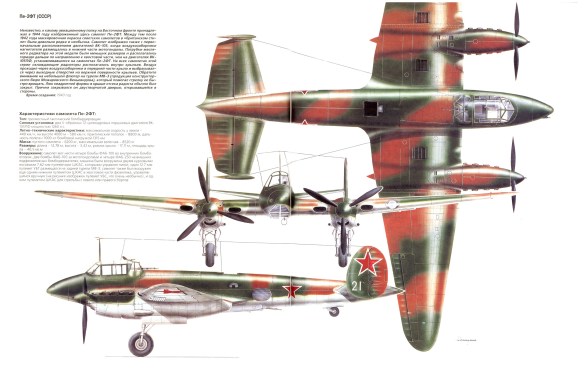The Petlyakov Pe-2 (nicknamed Peshka (“Pawn”; also a Russian diminutive for “little Pe”) was a Soviet dive bomber aircraft used during World War II. It was regarded as one of the best ground attack aircraft of the war and it was extremely successful in the roles of heavy fighter, reconnaissance and night fighter. It was one of the most important aircraft of World War II, being in many respects similar to the British de Havilland Mosquito, though the Pe-2 was manufactured in greater numbers: 11,400. It was fast, maneuverable and durable. Several Communist nations flew the type after the war, when it became known by the NATO reporting name Buck. Six captured Pe-2s were also transferred from the Germans to the Finnish Air Force during the Continuation War, with the serial code PE- and the unofficial nickname Pekka-Eemeli.
#
World War II bomber aircraft designed by V. M. Petlyakov. Vladimir Mikhailovich Petlyakov was born on 27 July 1891 and studied aerodynamics with Nikolai Zhukovsky, the father of Russian aviation. During the 1920s, he became one of the leading deputies of Andrei Tupolev, specializing in wing design. From October 1931, he was chief of the heavy aircraft design brigade, playing a central role in the design of the Maxim Gorky and the TB-3. In July 1937, Petlyakov, like many Soviet designers, was arrested and sent to a design prison (sharaga), officially for excessive delay in completing the ANT-42 heavy bomber, designated TB-7 by the air force, and later redesignated Pe-8 in his honor. While in prison he also designed the Pe-2, which became the standard wartime Soviet tactical bomber. After his release in 1940, Petlyakov was appointed director of his own design bureau in Kazan but was killed in a flying accident in January 1942.
The Pe-8, the only heavy bomber used by the Soviets during World War II, had four engines on the wings and a fifth mounted in the fuselage to power a compressor. It was not very successful, and only 91 were built. The Pe-8 conducted a number of raids on Berlin, Königsberg, and Danzig during 1941 but flew few missions during the rest of the war. Its most famous flight, on 19 May 1942, brought Foreign Minister V. M.Molotov and his staff to Britain.
Specifications (Pe-8/AM-35A)
General characteristics
- Crew: Eleven
- Length: 23.2 m (76 ft ¼ in)
- Wingspan: 39.13 m (128 ft 4 in)
- Height: 6.20 m (20 ft 4 in)
- Wing area: 188.66 m² (2,030.7 ft²)
- Empty weight: 18,571 kg (40,941 lb)
- Loaded weight: 27,000 kg (59,400 lb)
- Max. takeoff weight: 35,000 kg (77,000 lb)
- Powerplant: 4 × Mikulin AM-35A liquid-cooled V12 engine, 999 kW (1,340 hp) each
Performance
- Maximum speed: 443 km/h (275.2 mph)
- Range: 3,700 km (2,299 mi)
- Service ceiling: 9,300 m (30,504 ft)
- Rate of climb: 5.9 m/s (1,154 ft/min)
- Wing loading: 143 kg/m² (29 lb/ft²)
- Power/mass: 140 W/kg (0.2 hp/lb)
Armament
- Guns:
- 2 x 20-millimeter (0.79 in) ShVAK cannons (dorsal and tail turrets)
- 2 x 12.7-millimeter (0.50 in) UBT machine guns (engine nacelles)
- 2 x 7.62-millimeter (0.300 in) ShKAS machine guns (nose turret)
- Bombs: Up to 5,000 kg (11,000 lb)
Far more significant was the Pe-2, the standard twin-engine dive-bomber, with 11,467 examples built, including 365 fighter variants. Its speed and maneuverability made it difficult to intercept. After the war, many examples were handed down to Eastern European countries.
Variants Pe-2
In total, around 11,400 Pe-2s were built; a large number of minor variants were also developed.
- Pe-2B
- Standard bomber version from 1944.
- Pe-2D
- Three-seat bomber version, powered by two VK-107A piston engines.
- Pe-2FT
- Main production variant. In Czechoslovakia known as the B-32. Improved defensive armament (7.62 mm machine gun in dorsal turret), removal of the dive brakes, and an uprated engine. Nose glazing was also reduced.
- Pe-2FZ
- Built in small numbers.
- Pe-2I
- Improved version designed by Vladimir Myasishchev. VK-107 engines; revised wing profile; remote-controlled tail gun. Top speed 656 km/h (408 mph). Could carry 1,000 kg (2,204 lb) bombs. Five examples built.
- Pe-2K
- Radial-engined version, small number built.
- Pe-2K RD-1
- One Pe-2K equipped with additional RD-1 rocket engine. The 300 kg (661 lb) Glushko RD-1 rocket engine was installed in the tail of the aircraft.
- Pe-2M
- Variant of Pe-2I with heavier armament.
- Pe-2MV
- This version was armed with 20 mm ShVAK cannons and two 12.7 mm (0.5 in) in an underfuselage gondola, it also had one 7.62 mm (0.3 in) machine gun in the dorsal turret.
- Pe-2R
- Three-seat photo reconnaissance version, with a larger fuel tanks and extended range. small number built.
- Pe-2S
- Two-seat training version.
- Pe-2Sh
- The PB-100 prototype was fitted with two 20 mm ShVAK cannons, and a single 12.7 mm (0.5 in) machine gun was fitted beneath the fuselage.
- Pe-2VI
- High altitude fighter version.
- Pe-2UTI (UPe-2)
- Dedicated trainer version, small number built. In Czechoslovakia known as the CB-32.
- Pe-2 Paravan
- Anti-barrage balloon version.
- Pe-3
- Long-range night fighter version.
- Pe-4
- As Pe-2 except with Klimov VK-105PF engines.
